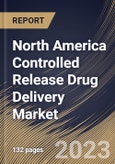Controlled release drug delivery permits a large decrease in dosage frequency and dose, prevents aberrant variations in plasma drug levels, enhances efficacy, increases patient compliance, and produces a consistent pharmacological effect of the supplied drug. Controlled releasedrug delivery systems, in contrast to conventional ones, achieve a longer therapeutic impact by releasing the drug at the target site at a predetermined time and with known drug release kinetics. As a result of these additional advantages, the controlled release delivery system's usage is risingnoticeably.
Over the course of the forecast period, it is anticipated that a shift in prescription patterns toward controlled release drug delivery over traditional systems due to advantages such as better patient compliance, high therapeutic efficacy,and lower treatment costs will aid in the market's expansion. Additionally, because of the intense competition and fragmentation of the market, pharmaceutical firms are proactive in responding to shifting consumer demands and are consistently investing in the development of these systems, which considerably increases demand.
Additionally, more than 1 in 5 people in the US are affected by a mental illness, according to the Centers for Disease Control and Prevention (CDC). Over 1 in 5 young people (ages 13 to 18) currently have, or had in the past, a mental condition that is considerably limiting. Bipolar disorder, schizophrenia, and major depression are among the serious mental diseases that affect one in every twenty-five Americans. Additionally, diabetes, cancer, and heart disease are among the chronic diseases that are the leading causes of death and disability in the US. Additionally, they play a significant role in the $4.1 trillion in annual healthcare costs for the nation.
The expanding need for controlled release medications in Canada is also a result of the rise in the prevalence of autoimmune diseases. According to Statistics Canada, 5.7 million people in Canada aged 15 or older (or 19.3%) reported having arthritis in 2017. 16.0% of males and 22.4% of women had this chronic condition, respectively. Moreover, in this region, there are numerous academic institutes and biotechnology companies working on the creation of controlled release medications. As a result, the market has attractive growth potential in the region.
The US market dominated the North America Controlled Release Drug Delivery Market by Country in 2022, and would continue to be a dominant market till 2030; thereby, achieving a market value of $30,656.8 million by 2030. The Canada market is anticipated to grow at a CAGR of 12.2% during (2023-2030). Additionally, The Mexico market would register a CAGR of 11.2% during (2023-2030).
Based on Release Mechanism, the market is segmented into Feedback Regulated Drug Delivery Systems, Activation-modulated Drug Delivery Systems, Chemically Activated, Polymer Based Systems and Micro Reservoir Partition Controlled Drug Delivery Systems. Based on Technology, the market is segmented into Targeted Delivery, Coacervation, Micro Encapsulation, Transdermal, Implants, Wurster Technique and Others. Based on Application, the market is segmented into Oral Controlled-drug delivery Systems, Metered Dose Inhalers, Injectable, Transdermal & Ocular Patches and Infusion Pumps & Drug Eluting Stents. Based on countries, the market is segmented into U.S., Mexico, Canada, and Rest of North America.
The market research report covers the analysis of key stake holders of the market. Key companies profiled in the report include Johnson & Johnson, Merck & Co., Inc., Alkermes PLC, Pfizer, Inc., Assertio Holdings, Inc. (Assertio Therapeutics, Inc.), Lonza Group AG (Capsugel), Colorcon, Inc. (BPSI Holdings LLC.), Corium, LLC (Gurnet Point Capital), Adare Pharma Solutions, and Coating Place, Inc.
Scope of the Study
By Release Mechanism
- Feedback Regulated Drug Delivery Systems
- Activation-modulated Drug Delivery Systems
- Chemically Activated
- Polymer Based Systems
- Micro Reservoir Partition Controlled Drug Delivery Systems
By Technology
- Targeted Delivery
- Coacervation
- Micro Encapsulation
- Transdermal
- Implants
- Wurster Technique
- Others
By Application
- Oral Controlled-drug delivery Systems
- Metered Dose Inhalers
- Injectable
- Transdermal & Ocular Patches
- Infusion Pumps & Drug Eluting Stents
By Country
- US
- Canada
- Mexico
- Rest of North America
Key Market Players
List of Companies Profiled in the Report:
- Johnson & Johnson
- Merck & Co., Inc.
- Alkermes PLC
- Pfizer, Inc.
- Assertio Holdings, Inc. (Assertio Therapeutics, Inc.)
- Lonza Group AG (Capsugel)
- Colorcon, Inc. (BPSI Holdings LLC.)
- Corium, LLC (Gurnet Point Capital)
- Adare Pharma Solutions
- Coating Place, Inc.
Unique Offerings
- Exhaustive coverage
- The highest number of Market tables and figures
- Subscription-based model available
- Guaranteed best price
- Assured post sales research support with 10% customization free
Table of Contents
Companies Mentioned
- Johnson & Johnson
- Merck & Co., Inc.
- Alkermes PLC
- Pfizer, Inc.
- Assertio Holdings, Inc. (Assertio Therapeutics, Inc.)
- Lonza Group AG (Capsugel)
- Colorcon, Inc. (BPSI Holdings LLC.)
- Corium, LLC (Gurnet Point Capital)
- Adare Pharma Solutions
- Coating Place, Inc.








